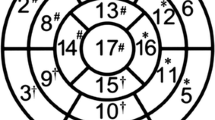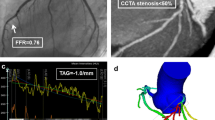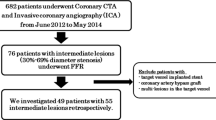Abstract
Background
Semi-quantitative stenosis assessment by coronary CT angiography only modestly predicts stress-induced myocardial perfusion abnormalities. The performance of quantitative CT angiography (QCTA) for identifying patients with myocardial perfusion defects remains unclear.
Methods
CorE-64 is a multicenter, international study to assess the accuracy of 64-slice QCTA for detecting ≥50% coronary arterial stenoses by quantitative coronary angiography (QCA). Patients referred for cardiac catheterization with suspected or known coronary artery disease were enrolled. Area under the receiver-operating-characteristic curve (AUC) was used to evaluate the diagnostic accuracy of the most severe coronary artery stenosis in a subset of 63 patients assessed by QCTA and QCA for detecting myocardial perfusion abnormalities on exercise or pharmacologic stress SPECT.
Results
Diagnostic accuracy of QCTA for identifying patients with myocardial perfusion abnormalities by SPECT revealed an AUC of 0.71, compared to 0.72 by QCA (P = .75). AUC did not improve after excluding studies with fixed myocardial perfusion abnormalities and total coronary arterial occlusions. Optimal stenosis threshold for QCTA was 43% yielding a sensitivity of 0.81 and specificity of 0.50, respectively, compared to 0.75 and 0.69 by QCA at a threshold of 59%. Sensitivity and specificity of QCTA to identify patients with both obstructive lesions and myocardial perfusion defects were 0.94 and 0.77, respectively.
Conclusions
Coronary artery stenosis assessment by QCTA or QCA only modestly predicts the presence and the absence of myocardial perfusion abnormalities by SPECT. Confounding variables affecting the relationship between coronary anatomy and myocardial perfusion likely account for some of the observed discrepancies between coronary angiography and SPECT results.




Similar content being viewed by others
References
Arbab-Zadeh A, Miller JM, Rochitte C, Dewey M, Niinuma H, Gottlieb I, et al. Diagnostic accuracy of CT coronary angiography according to coronary arterial calcification and pretest probability of coronary artery disease: The CorE-64 International. Multicenter Study. J Am Coll Cardiol 2012;59:379-87.
Tonino PA, De Bruyne B, Pijls NH, Siebert U, Ikeno F, van’t Veer M, et al. Fractional flow reserve versus angiography for guiding percutaneous coronary intervention. N Engl J Med 2009;360:213-24.
Hamilos M, Muller O, Cuisset T, Ntalianis A, Chlouverakis G, Sarno G, et al. Long-term clinical outcome after fractional flow reserve-guided treatment in patients with angiographically equivocal left main coronary artery stenosis. Circulation 2009;120:1505-12.
Bartunek J, Sys SU, Heyndrickx GR, Pijls NH, De Bruyne B. Quantitative coronary angiography in predicting functional significance of stenoses in an unselected patient cohort. J Am Coll Cardiol 1995;26:328-34.
Abizaid A, Mintz GS, Pichard AD, Kent KM, Satler LF, Walsh CL, et al. Clinical, intravascular ultrasound, and quantitative angiographic determinants of the coronary flow reserve before and after percutaneous transluminal coronary angioplasty. Am J Cardiol 1998;82:423-8.
Topol EJ, Nissen SE. Our preoccupation with coronary luminology. The dissociation between clinical and angiographic findings in ischemic heart disease. Circulation 1995;92:2333-42.
Isner JM, Kishel J, Kent KM, Ronan JA Jr, Ross AM, Roberts WC. Accuracy of angiographic determination of left main coronary arterial narrowing. Angiographic-histologic correlative analysis in 28 patients. Circulation 1981;63:1056-64.
Caussin C, Larchez C, Ghostine S, Pesenti-Rossi D, Daoud B, Habis M, et al. Comparison of coronary minimal lumen area quantification by sixty-four-slice computed tomography versus intravascular ultrasound for intermediate stenosis. Am J Cardiol 2006;98:871-6.
Arbab-Zadeh A, Texter J, Ostbye KM, Kitagawa K, Brinker J, George RT, et al. Quantification of lumen stenoses with known dimensions by conventional angiography and computed tomography: Implications of using conventional angiography as gold standard. Heart 2010;96:1358-63.
Meijboom WB, Van Mieghem CA, van Pelt N, Weustink A, Pugliese F, Mollet NR, et al. Comprehensive assessment of coronary artery stenoses: Computed tomography coronary angiography versus conventional coronary angiography and correlation with fractional flow reserve in patients with stable angina. J Am Coll Cardiol 2008;52:636-43.
Wijpkema JS, Dorgelo J, Willems TP, Tio RA, Jessurun GA, Oudkerk M, et al. Discordance between anatomical and functional coronary stenosis severity. Neth Heart J 2007;15:5-11.
Miller JM, Dewey M, Vavere AL, Rochitte CE, Niinuma H, Arbab-Zadeh A, et al. Coronary CT angiography using 64 detector rows: Methods and design of the multi-centre trial CORE-64. Eur Radiol 2009;19:816-28.
Hammer-Hansen S, Kofoed KF, Kelbaek H, Kristensen T, Kuhl JT, Thune JJ, et al. Volumetric evaluation of coronary plaque in patients presenting with acute myocardial infarction or stable angina pectoris—a multislice computerized tomography study. Am Heart J 2009;157:481-7.
Motoyama S, Sarai M, Harigaya H, Anno H, Inoue K, Hara T, et al. Computed tomographic angiography characteristics of atherosclerotic plaques subsequently resulting in acute coronary syndrome. J Am Coll Cardiol 2009;54:49-57.
Austen WG, Edwards JE, Frye RL, Gensini GG, Gott VL, Griffith LS, et al. A reporting system on patients evaluated for coronary artery disease. Report of the Ad Hoc Committee for Grading of Coronary Artery Disease, Council on Cardiovascular Surgery, American Heart Association. Circulation 1975;51:5-40.
Hendel RC, Wackers FJ, Berman DS, Ficaro E, DePuey EG, Klein L, et al. American Society of Nuclear Cardiology consensus statement: Reporting of radionuclide myocardial perfusion imaging studies. J Nucl Cardiol 2006;13:2152-6.
Gaemperli O, Schepis T, Koepfli P, Valenta I, Soyka J, Leschka S, et al. Accuracy of 64-slice CT angiography for the detection of functionally relevant coronary stenoses as assessed with myocardial perfusion SPECT. Eur J Nucl Med Mol Imaging 2007;34:1162-71.
Gaemperli O, Schepis T, Valenta I, Koepfli P, Husmann L, Scheffel H, et al. Functionally relevant coronary artery disease: Comparison of 64-section CT angiography with myocardial perfusion SPECT. Radiology 2008;248:414-23.
Hacker M, Jakobs T, Hack N, Nikolaou K, Becker C, von Ziegler F, et al. Sixty-four slice spiral CT angiography does not predict the functional relevance of coronary artery stenoses in patients with stable angina. Eur J Nucl Med Mol Imaging 2007;34:4-10.
Hacker M, Jakobs T, Hack N, Nikolaou K, Becker C, von Ziegler F, et al. Combined use of 64-slice computed tomography angiography and gated myocardial perfusion SPECT for the detection of functionally relevant coronary artery stenoses. First results in a clinical setting concerning patients with stable angina. Nuklearmedizin 2007;46:29-35.
Schuijf JD, Wijns W, Jukema JW, Atsma DE, de Roos A, Lamb HJ, et al. Relationship between noninvasive coronary angiography with multi-slice computed tomography and myocardial perfusion imaging. J Am Coll Cardiol 2006;48:2508-14.
Bauer RW, Thilo C, Chiaramida SA, Vogl TJ, Costello P, Schoepf UJ. Noncalcified atherosclerotic plaque burden at coronary CT angiography: A better predictor of ischemia at stress myocardial perfusion imaging than calcium score and stenosis severity. AJR Am J Roentgenol 2009;193:410-8.
Takagi A, Tsurumi Y, Ishii Y, Suzuki K, Kawana M, Kasanuki H. Clinical potential of intravascular ultrasound for physiological assessment of coronary stenosis: Relationship between quantitative ultrasound tomography and pressure-derived fractional flow reserve. Circulation 1999;100:250-5.
Gould KL. Does coronary flow trump coronary anatomy? JACC Cardiovasc Imaging 2009;2:1009-23.
Melikian N, De Bondt P, Tonino P, De Winter O, Wyffels E, Bartunek J, et al. Fractional flow reserve and myocardial perfusion imaging in patients with angiographic multivessel coronary artery disease. JACC Cardiovasc Interv 2010;3:307-14.
Ragosta M, Bishop AH, Lipson LC, Watson DD, Gimple LW, Sarembock IJ, et al. Comparison between angiography and fractional flow reserve versus single-photon emission computed tomographic myocardial perfusion imaging for determining lesion significance in patients with multivessel coronary disease. Am J Cardiol 2007;99:896-902.
Di Carli MF, Dorbala S, Curillova Z, Kwong RJ, Goldhaber SZ, Rybicki FJ, et al. Relationship between CT coronary angiography and stress perfusion imaging in patients with suspected ischemic heart disease assessed by integrated PET-CT imaging. J Nucl Cardiol 2007;14:799-809.
Gottsauner-Wolf M, Sochor H, Moertl D, Gwechenberger M, Stockenhuber F, Probst P. Assessing coronary stenosis. Quantitative coronary angiography versus visual estimation from cine-film or pharmacological stress perfusion images. Eur Heart J 1996;17:1167-74.
Javadi MS, Lautamaki R, Merrill J, Voicu C, Epley W, McBride G, et al. Definition of vascular territories on myocardial perfusion images by integration with true coronary anatomy: A hybrid PET/CT analysis. J Nucl Med 2010;51:198-203.
Author information
Authors and Affiliations
Corresponding author
Rights and permissions
About this article
Cite this article
Godoy, G.K., Vavere, A., Miller, J.M. et al. Quantitative coronary arterial stenosis assessment by multidetector CT and invasive coronary angiography for identifying patients with myocardial perfusion abnormalities. J. Nucl. Cardiol. 19, 922–930 (2012). https://doi.org/10.1007/s12350-012-9598-6
Received:
Accepted:
Published:
Issue Date:
DOI: https://doi.org/10.1007/s12350-012-9598-6




